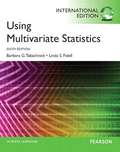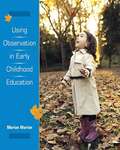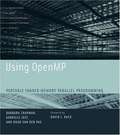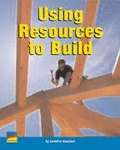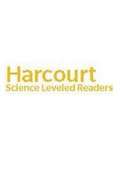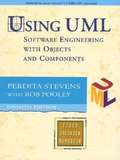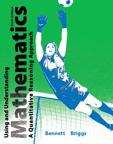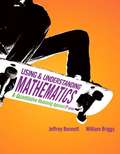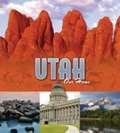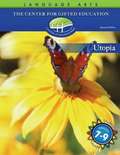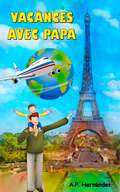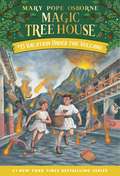- Table View
- List View
Using Math in Science
by Kathy Furgang Brett KellyMath is a powerful tool for communication. Without the language of math, science would cease to exist. Read this book to find out the many different ways we use math to understand and change the world around us. (Set of 10)
Using Multivariate Statistics Sixth Edition
by Barbara G. Tabachnick Linda S. FidellThe book provides advanced undergraduate as well as graduate students with a timely and comprehensive introduction to today's most commonly encountered statistical and multivariate techniques, while assuming only a limited knowledge of higher-level mathematics.
Using Observation In Early Childhood Education
by Marian MarionWritten by a prolific, well-respected author, this book teaches how to observe, document, and assess children's development and progress—emphasizing how powerful ethical, responsible observation can be in a teacher's professional life. Focusing on observations as an intrinsic part of authentic assessment, the author advocates a protective, respectful attitude toward it. Provides an overview of various informal and formal observation and assessment strategies, as well as instruction in how to embed observation into the daily routine of the early childhood classroom. Explores ways to prevent problems, ways to solve problems, and ways to work cooperatively with parents. Included is coverage of the ethics of observation and the pros and cons of standardized testing as it relates to observation and assessment. For early childhood teachers.
Using OpenMP: Portable Shared Memory Parallel Programming
by Barbara Chapman Gabriele Jost David J. Kuck Ruud Van Der PasThis book should provide an excellent introduction to beginners, and the performance section should help those with some experience who want to push OpenMP to its limits.
Using Resources to Build
by Vicki Rushworth David Haggerty Jennifer BoudartIn this book, learn about the natural resources used to make glass, lumber, and tiles for home building.
Using Resources: Blw-lv Rdr Using Resourcs G5 Sci09 (Science Leveled Readers Ser.)
by Harcourt School Publishers HspNIMAC-sourced textbook
Using Sources Effectively: Strengthening Your Writing and Avoiding Plagiarism (2nd edition)
by Robert A. HarrisThe overall goal of this book is to help you write better research papers, principally by incorporating sources into your work more effectively and accurately. However, a preliminary question may have arisen in your mind: Why do you have to do a research paper anyway? Why do instructors assign them?
Using Sources Effectively: Strengthening Your Writing and Avoiding Plagiarism (3rd Edition)
by Robert A. HarrisUsing Sources Effectively is designed to assist you, the writer of a research paper, with practical and effective strategies for incorporating sources into your work. You will learn how the skillful use of sources adds strength to your argument and interest to your writing. You will also learn what you need to know to avoid plagiarism as you bring source material into your research paper. The book includes many examples and ideas to help you make your writing especially good.
Using UML: Software Engineering with Objects and Components
by Perdita Stevens; Rob PooleyIt places UML in the context of the software engineering discipline as a whole, providing students with a practical understanding of good practice in software design and development. The authors present a broad view of the subject area, enabling students to see for themselves how different practices may be appropriate for different situations.
Using a Net
by Jessica QuiltyThe fun and excitement of English and Language Arts learning continues in Grade 2 of Reading Street. This comprehensive and dynamic curriculum for homeschooling is geared toward young children who have some foundational English and Language Arts knowledge and are ready to strengthen their skills. Comprised of engaging activities, challenging content and weekly quizzes, Reading Street: Grade 2 is the next step in your child's path toward becoming a lifelong learner and reader. As with all Reading Street products, the Grade 2 system is formatted to help students meet certain age-appropriate goals. After completing this English and Language Arts homeschool program, your child should be able to: Read and comprehend two-syllable words. Identify common prefixes (such as pre-, un-, or re-) and suffixes (such as -able, -ad and -er). Correct mistakes made when reading out loud. Read books with two or more chapters. Understand the structure of stores (i. e. beginning, middle and end). Start selecting reading materials based on his/her own interests. Identify the "who," "what," "when," "where," "why" and "how" of the text. While the goals of second Grade English and Language Arts are numerous, Reading Street will help you craft engrossing lessons. Your child will garner important English and Language Arts skills while completing a workbook, reading stories and poems, and taking assessments. Planning these lessons will be easier than ever, as all Reading Street systems are broken down into weekly Big Ideas. All the work your child does on a given week is formulated around that single concept for an organized and challenging curriculum. With six easy-to-follow units, Reading Street: Grade 2 is the perfect tool for homeschooling parents. Your child will enjoy the reading selections and activities, and you'll love to see your student growing into a knowledgeable individual. We're confident that this product is the right one for you. For more information on the specific materials found in Grade 2 of Reading Street, check out the Features and Benefits page.
Using and Understanding Mathematics: A Quantitative Reasoning Approach
by Jeffrey Bennett William BriggsUsing and Understanding Mathematics: A Quantitative Reasoning Approach prepares students for the mathematics they will encounter in college courses, their future career, and life in general. Its quantitative reasoning approach helps students to build the skills needed to understand major issues in everyday life, and compels students to acquire the problem-solving tools that they will need to think critically about quantitative issues in contemporary society.
Using and Understanding Mathematics: A Quantitative Reasoning Approach (5th Edition)
by Jeffrey O. Bennett William L. BriggsUsing and Understanding Mathematics: A Quantitative Reasoning Approach, Fifth Edition increases readers' mathematical literacy so that they better understand the mathematics used in their daily lives, and can use math effectively to make better decisions every day. Contents are organized with that in mind, with engaging coverage in sections like Taking Control of Your Finances, Dividing the Political Pie, and a full chapter about Mathematics and the Arts. Prologue: Literacy for the Modern World. Logic and Problem Solving:Thinking Critically; Approaches to Problem Solving. Quantitative Information in Everyday Life:Numbers in the Real World; Managing Your Money. Probability and Statistics:Statistical Reasoning; Putting Statistics to Work; Probability: Living with the Odds. Modeling:Exponential Astonishment; Modeling Our World; Modeling with Geometry. Further Applications:Mathematics and the Arts; Mathematics and Politics; Mathematics and Business. For all readers interested in a quantitative reasoning approach to using and understanding mathematics.
Utopia (Second Edition)
by Center for Gifted EducationA guide to take the students through language arts unit, Utopia, making the concept understandable, as it applies discussions, writing, listening, vocabulary study and research activities.
Utopia: Man's Changing Ideas of the Ideal
by Center for Gifted Education StaffA collection of short stories and essays that form part of the literary works in the study of literature for all students
Vacaciones en el bosque lluvioso (¡Arriba la Lectura! Level P #29)
by Margaret FettyNIMAC-sourced textbook <p><p> ¡Vamos al bosque lluvioso de Brasil! Descubrirás plantas coloridas e insectos extraños. Te encontrarás con cocodrilos, monos y animales que no sabías que existían. También aprenderás por qué se están destruyendo algunas partes del bosque lluvioso.
Vacaciones en el espacio (¡Arriba la Lectura! Level M #65)
by Richard Hoit Phillip SimpsonNIMAC-sourced textbook <p><p> Ana, Jake y sus padres viajarán por el espacio en una nave espacial para ir al Planeta Diversión a pasar las vacaciones. Todos están muy contentos… ¡hasta que ven un objeto enorme en su camino! ¿Podrán llegar al Planeta Diversión?
Vacances avec papa: Livre pour enfants de 6 à 7 ans : un voyage très spécial !
by A. P. HernándezHugo est très nerveux ! En huit ans, il n'a jamais quitté l'Espagne. Mais tout va changer un matin lorsque son papa lui propose un voyage très spécial dans son camion, Rapide Éclair. Découvrez ses aventures !
Vacation Under the Volcano
by Mary Pope Osborne Sal MurdoccaThe #1 bestselling chapter book series of all time celebrates 25 years with new covers and a new, easy-to-use numbering system! Who wants to vacation next to a volcano? Jack and Annie are about to find out when the Magic Tree House whisks them back to the days of the Roman Empire. They arrive in Pompeii and soon discover that it is the very day the city will be destroyed. Now Jack and Annie must race against time to find an ancient library before it is buried in ash! Did you know that there’s a Magic Tree House book for every kid? Magic Tree House: Adventures with Jack and Annie, perfect for readers who are just beginning chapter books Merlin Missions: More challenging adventures for the experienced reader Super Edition: A longer and more dangerous adventure Fact Trackers: Nonfiction companions to your favorite Magic Tree House adventures Have more fun with Jack and Annie at MagicTreeHouse.com!
Vacation Under the Volcano (Magic Tree House #13)
by Mary Pope Osborne Sal MurdoccaJack and Annie are ready for their next fantasy adventure in the bestselling middle-grade series--the Magic Tree House! Who wants to vacation next to a volcano?Jack and Annie are about to find out when the Magic Tree House whisks them back to the days of the Roman Empire. They arrive in Pompeii and soon discover that it is the very day the city will be destroyed. Now Jack and Annie must race against time to find an ancient library before it is buried in ash! Visit the Magic Tree House website! MagicTreeHouse.comFrom the Trade Paperback edition.
Vaikashik Manasashastra SYBA Third Semester - SPPU: वैकासिक मानसशास्त्र एस.वाय.बी.ए. सेमिस्टर ३ - सावित्रीबाई फुले पुणे यूनिवर्सिटी
by Dr K. M. Jadhavपुणे विद्यापीठाच्या मानसशास्त्र अभ्यास मंडळाने प्रथम वर्षापासून ते तृतीय वर्षापर्यंतचे मानसशास्त्राचे सर्व अभ्यासक्रम अद्ययावत केले. त्यामध्ये द्वितीय वर्षाच्या विशेष स्तरावरील स्पेशल पेपर-१ साठी वैकासिक मानसशास्त्र या विषयाचा समावेश केलेला आहे. त्यानुसार या पुस्तकाचे लेखन करण्याचा प्रयत्न केलेला आहे. संपूर्ण अभ्यासक्रम इंग्रजी पुस्तकाच्या आधारे तयार केलेला आहे. त्या इंग्रजी पुस्तकाचा संदर्भ घेऊन, काही भारतीय जीवनातील उदाहरणे देऊन मुद्दे स्पष्ट करण्याचा प्रयत्न केलेला आहे. मूळ पुस्तक पाश्चात्त्य संस्कृतीला धरून असल्यामुळे ते संदर्भ वेगळे वाटण्याची शक्यता आहे. परंतु त्यात फारसा तांत्रिक बदल करता येत नाही. तरी साध्या व सोप्या भाषेत सदर पुस्तक प्रकाशित केले आहे.

